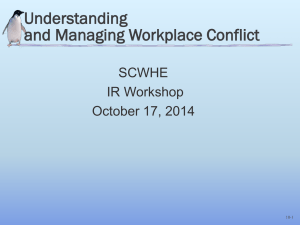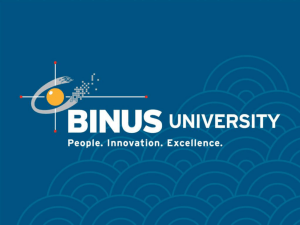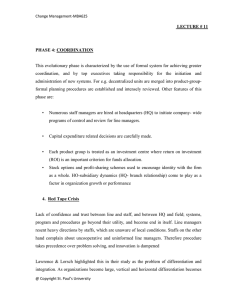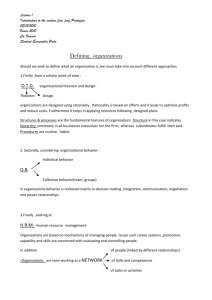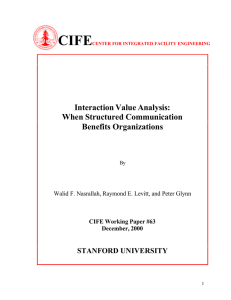ORGANIZING
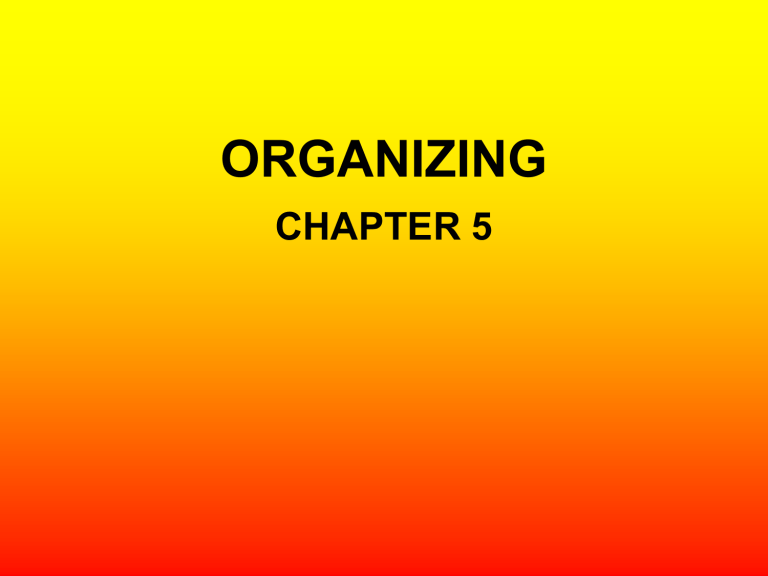
ORGANIZING
CHAPTER 5
INTRODUCTION
• Organizing means arranging the activities of the enterprise in such a way that they systematically contribute to the enterprise’s goals.
Principle of Organizational
Structure
• Organizational structure can be defined as the sum of the ways an organization divides its labor into distinct tasks and then coordinates them.
• There are 5 concepts of organizational structure such as:
1. Differentiation
2. Integration
3. Formalization
4. Informalization
5. Centralization and Decentralization
1. Differentiation
• The extent to which tasks are divided into subtasks and performed by individuals with specialized skills.
• The main benefit of differentiation is greater specialization.
• There are 4 primary types of differentiation: task, cognitive, horizontal and vertical differentiation.
Task Differentiation
The extent to which tasks are divided.
For example: Accounting dept think about asset and liabilities whereas marketing dept think about brand name and market share.
Cognitive Differentiation exists when people in different units within the organization think about different things and think about similar things differently.
For example: Accountants might think about organizational performance in terms of financial results, while marketers might think about organizational performance in terms of customer satisfaction.
Horizontal Differentiation refers to the specialization of tasks across the organization. The greater the division and specialization of task, the greater the horizontal differentiation.
For example: Air Asia
Vertical Differentiation occurs when tasks are subdivided and carried out by specialized individuals from top to the bottom of the organization’s hierarchy.
For example: MAS
2. Integration
• The extent to which various parts of the organization cooperate and interact with each other.
• Through integration, employees from different units can work together to achieve company objectives or goals.
• There are 3 types of interdependences such as pooled interdependence, sequential interdependence and reciprocal interdependence .
• The greater the interdependence, the greater the need for cooperation and thus integration.
Pooled Interdependence
• Occurs when various groups are largely independent in their functions but collectively contribute to a common output.
• For example, 2 product divisions might send products to the same customer to meet the customer’s overall need.
Sequential Interdependence
• Exists when the outputs of one group become the inputs of another group.
• For example, when the raw materials provided by the purchasing department become the inputs of the manufacturing department, whose outputs become the inputs of the sales department.
Reciprocal Interdependence
• Exists when 2 or more groups depend on one another for inputs.
• For example, when the new product development department relies on the marketing research department for ideas to investigate and marketing research relies on new product development for new products to test on customers.
Mechanisms of Integration
• Rules
guidelines for behavior and consequence
the standard operating procedures
• Goals
specify what outcomes individuals should achieve
effective goals define quantitative outcomes and often require high levels of effort to achieve
• Values
specify underlying objectives, such as customer satisfaction, but unlike goals, they do not specify quantitative outcomes.
3. Formalization
• Formal systems specify clear lines of authority within an organization, or who reports to whom.
• Firms with strong formalization rely in the chain of command for decision making, communication and control.
• Chain of command specifies the sequence of people through whom information and decisions should flow.
• Formal systems often also stress unity of command.
• Formal systems tend to specify span of control.
4. Informalization
• Informal structures for decision making, communication and control are often not represented in organizational charts, yet they pervade the day-to-day functioning of many organizations
• Much of the decision making, communication and control were accomplished through informal, face-to-face meetings between people who did not have formal reporting relationships.
5. Centralization and
Decentralization
• Centralized organizations tend to restrict decision making to fewer individual, usually at the top of management.
• Decentralized organizations tend to push decision making authority down to the lowest possible level.
DESIGNING ORGANIZATIONS
• Crucial determinants of appropriate organizational design are the internal and external environments of the organization and the extent to which those environments are simple or complex and static or dynamic.
1. Environmental Complexity
• Simple environments exist when relatively few internal and external variables need to be incorporated into decision making and these variables are similar.
• For example, a Bic Pen is made up of approximately 7 parts. Each part is produced with relatively low technology and the assembly of the parts into the final product also involves relatively low technology.
• Complex environments exist when a great number and dissimilar variables can affect decision making.
• For example, when Boeing puts together a
747 Jumbo Jet, it must assemble over 6 million parts that range from a simple metal bolt to a panel composed of rare composite materials.
a) Internal Environment Complexity
3 general factors that affect the simplicity or complexity of an organization’s internal environment are:
1) the organization’s personnel
2) the organization’s functional and staff unit
3) the nature of the organization’s product or service and its related goals play a critical role in the internal environment.
b) External Environment Complexity
